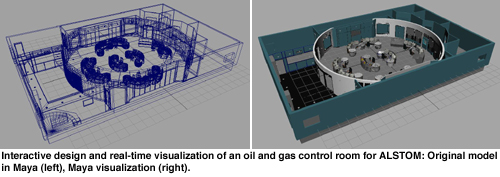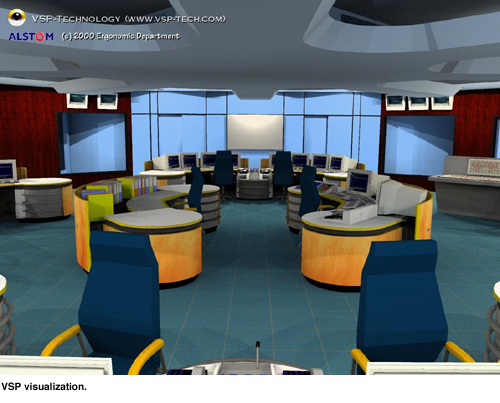
ERCIM News No.44 - January 2001 [contents]

![]()
ERCIM News No.44 - January 2001 [contents]
by Xavier Cavin and François Cuny
VSP Technology (Visualization Service ProviderTM) is a new start-up company born from a technology transfer from INRIA and providing services for a realistic and interactive visualization of complex 3D models. The core technology relies on an advanced rendering software developed at INRIA Lorraine within the ISA research team. The innovative objective of VSP is to offer a new approach of real-time visualization through the Internet as an Application Service Provider (ASP).
Virtual prototyping is expected by the industrial world to offer an important competitive advantage in comparison with traditional prototyping techniques. On one hand, it allows to greatly reduce the design times and costs of new products; on the other hand it may advantageously assist the marketing and the high-end management in their making decisions. However, existing visualization solutions continue to suffer from too many limitations that have restricted their spread and use: physical inaccuracy, very rough visual perception, poor interactivity and over all an incapacity of coping with the scale required by industrial applications.
VSP Technology provides solutions for high quality virtual prototyping of very large sized numerical models for industries such as automobile, aeronautics, energy, architecture, etc through an advanced system of geometric optimization, numerical physically based simulation and real-time images generation, directly following from the most recent research in the field of computer graphics.
The process of Visualization Service Providing can be decomposed into three phases: geometric and physical modelling, light transfer simulation and interactive visualization.
For immediate integration purpose, the geometric 3D model can directly come from the traditional CAD/CAM/CAE modelling tools used in the industry, such as CATIATM or MayaTM. Unlike standard CAD polygon-based interchange vocabulary, our loading module generates a compact mathematical representation of the initial geometry that preserves the topological properties of the objects. In addition, physical and spectral properties of surfaces and light sources are taken into account into the model using standard industrial data formats, in order to ensure the physical accuracy of its numerical representation.


Then, the propagation of light in the model is computed from a global physical simulation based on a high performing radiosity algorithm. This algorithm efficiently performs the calculations using high order wavelet functions on parametric surfaces, and can take advantage of existing multi-processor: it can thus be applied with extreme precision and speed to models of very large size. By contrast to classical Monte Carlo ray tracing approaches giving static images, the radiosity method results in a view-independent solution, meaning that views can be displayed without requiring any supplementary lighting computation.
The final step consists in interactively visualizing the illuminated model. Thanks to advanced techniques - including lighting textures, level of details and optimal mesh simplifications - intensively using graphics hardware acceleration, realistic images can be displayed with a high resolution at a high frequency. Supplementary complex optical effects (that were indirectly taken into account in the original simulation) can be added in real-time, and some modifications can be applied to the model, updating the solution accordingly.
Furthermore, a strong concept of VSP Technology is to put forward the complete visualization solution in an Application Service Provider type of process. This concept must allow users to make the most of all the technological power of VSP Technology via the Internet, and to focus all their efforts on their know-how by leaving apart all hardware and software aspects. No matter where they are located in the world and regardless of which resources (high-end or low-end) they are in dispose of, they will be able to interactively visualize and modify their numerical models, even the most complex and largest ones, with a never achieved realism.
The objective of VSP Technology is to bring the academic results of the research made at INRIA to a competitive technology. This work will be done in collaboration with the ISA (Nancy) and iMAGIS (Grenoble) INRIA research teams on one hand, and our strategic partner SGI on the other hand. In particular, INRIA is involved with France Telecom in the RNRT/VTHD project, whose objective is to settle a very high bandwidth network (2.5 Gbits/s) between the five INRIA institutes (Paris, Grenoble, Nancy, Nice and Rennes): this network will help us to conduct experimentations of the ASP aspects and to validate this approach.
Links:
http://www.vsp-tech.com
http://www.loria.fr/isa
Please contact:
François Cuny - INRIA
Tel: +33 3 83 59 20 30
E-mail: cuny@vsp-tech.com
http://www.loria.fr/~cuny
Xavier Cavin INRIA
Tel: +33 3 83 59 20 93
E-mail: cavin@vsp-tech.com
http://www.loria.fr/~cavin